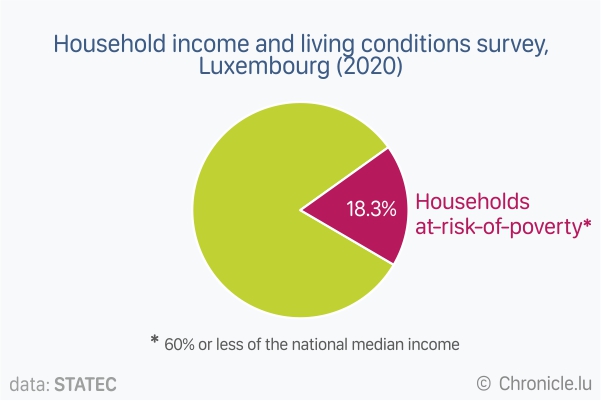
Luxembourg's statistical institute, STATEC, has published the results of the survey on household income and living conditions (SILC) in 2020.
According to this report, the forecasts of the latest "Report on work and social cohesion", published in October 2021, are confirmed: household disposable income has increased despite the health crisis and has been less affected than initially estimated. The average monthly disposable income per household increased to €6,247 in 2020, i.e. by 9.3% compared to 2019. This increase in income concerns all households, even if it is above all high salaries that have recorded the strongest increases. The income of vulnerable households has also increased; through the doubling of the cost of living allowance, the increase in the minimum social wage as well as indexation in 2020.
The crisis has not widened inequalities as much in 2020. The comparison between the wealthiest and the most disadvantaged individuals shows that in 2020, the wealthiest 20% have an income on average 4.6 times higher than the 20% of the least well-off (a decrease of 0.4% compared to 2019). The wealthiest 10% had an income 7.1 times higher than the most disadvantaged 10% (a decrease of 1% compared to 2019).
The increase in income is accompanied by an increase in the poverty rate; the latter thus deteriorated compared to forecasts. Low-income households are all the more likely to slide into poverty. The at-risk-of-poverty rate stands at 18.3% in 2020, and is above the 2019 rate of 17.4%. This increase is confirmed by data on the ability to make ends meet, which had increased in 2020 to 26.5%, compared to 24.9% in 2019. The upward trend in the poverty rate is expected to continue in 2021, according to the forecast.
The SILC survey will be modernised in 2022
STATEC has undertaken a vast modernisation of its SILC survey, aimed above all at increasing the comfort of participating households. The survey on household income and living conditions concerns more than 4,000 households and collects information on the resources available to households, their housing, their work, their education and their health. It is a key source for measuring the evolution of society and the well-being of Luxembourg residents. The survey also makes it possible to measure the effectiveness of policies and the fight against poverty and social exclusion.
From then on, households will be able to participate according to their mode of preference; via a face-to-face interview, via telephone or online. STATEC also integrates administrative sources from the General Social Security Inspectorate (Inspection générale de la sécurité sociale - IGSS) into its statistics in order to provide high-quality statistical information on household income in Luxembourg, increasingly in real time. The launch of this survey is scheduled for 26 September 2022.
Publication of the new “Work and Social Cohesion” report on 14 October 2022
The "Work and Social Cohesion Report" is one of STATEC's flagship publications and presents the most recent figures on the socio-economic situation in Luxembourg: population, labour market, inequality and poverty. The next report will be presented on 14 October 2022.
Methodological note
The COVID-19 pandemic has had a significant impact on the 2020 wave of the SILC survey, which is based on continuous household participation for four consecutive years. The pandemic not only changed the survey mode from face-to-face to online survey, it also changed the sample of participating households. Thus, the results for 2020 must be considered as a break in the series and comparability with previous survey waves is therefore no longer guaranteed.








